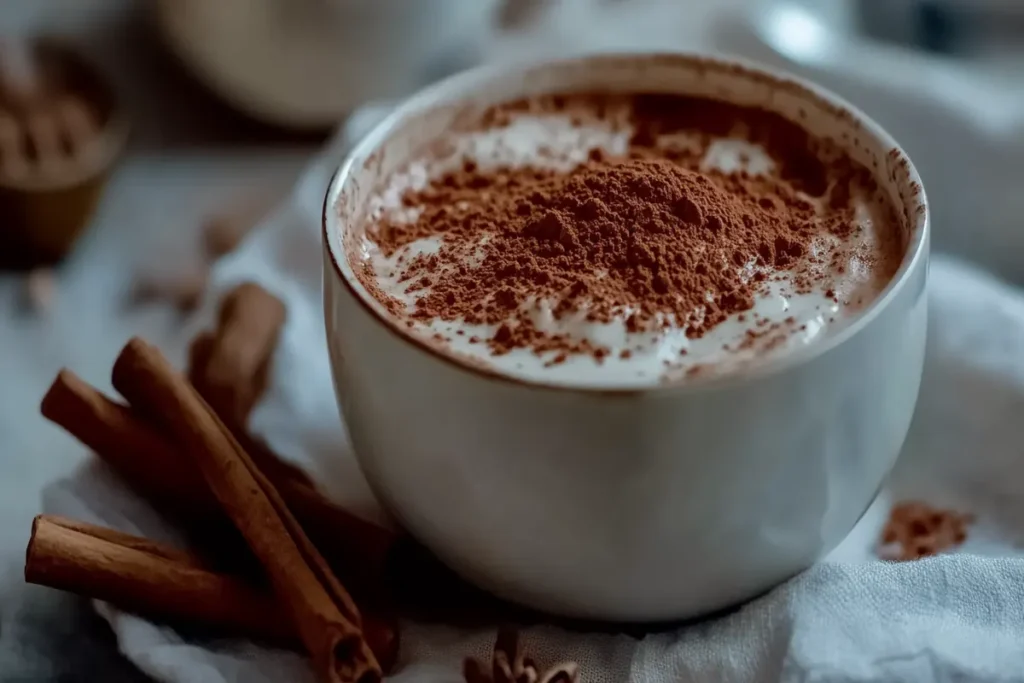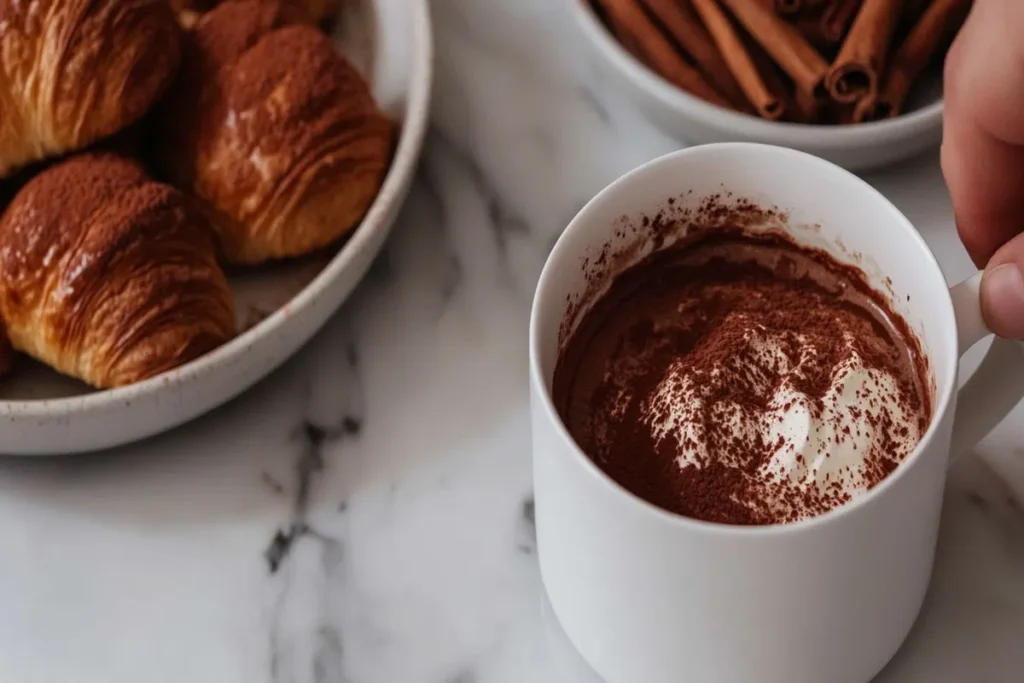Introduction
Let’s be honest—hot chocolate isn’t just a drink. It’s a hug in a mug, a little piece of comfort on a cold day, and the ultimate cozy treat. But making the perfect hot chocolate? That’s where things get tricky.

Maybe you’ve ended up with something too watery, too sweet, or just plain boring. I’ve been there. After plenty of trial and error (and way too many taste tests), I’ve rounded up the best tips to help you make hot chocolate that’s rich, creamy, and full of deep chocolate flavor.
Whether you like it classic, extra thick, or dairy-free, these tricks will level up your hot chocolate game. But before we get to the tips, let’s take a step back and appreciate the history, culture, and variations of this beloved drink.
What is Hot Chocolate?
Hot chocolate is a warm, chocolate-based beverage made with milk (or water), chocolate, and a sweetener. It’s often confused with hot cocoa, but there’s a difference:
- Hot Cocoa: Made with cocoa powder, sugar, and milk or water. It’s lighter and sweeter.
- Hot Chocolate: Uses real melted chocolate, making it thicker, creamier, and more indulgent.
No matter how you prepare it, the best hot chocolate should be smooth, velvety, and packed with deep chocolate flavor.
A Brief History of Hot Chocolate
Hot chocolate has a long and fascinating history, dating back to ancient Mesoamerican civilizations. The Maya and Aztecs were the first to consume a form of hot chocolate over 3,000 years ago, though their version was quite different from today’s sweet and creamy drink.
Modern Hot Chocolate (1800s – Today): With the industrial revolution, cocoa powder became widely available, making hot chocolate accessible to all. Today, hot chocolate is enjoyed worldwide, with unique variations in different cultures.
Mayan Hot Chocolate (1500 BCE – 900 CE): Made by grinding cocoa beans, mixing them with water, and adding spices like chili and vanilla. It was unsweetened and often frothed by pouring it between cups.
Aztec Hot Chocolate (1200s – 1500s CE): Known as “xocoatl,” it was reserved for the elite, warriors, and royalty. It was bitter, mixed with maize (corn), and considered an energizing and sacred drink.
Introduction to Europe (1500s – 1600s CE): Spanish explorers brought cocoa to Europe, where sugar and milk were added, creating the sweeter version we know today. It quickly became a popular luxury drink among European aristocracy.
The Cultural and Seasonal Significance of Hot Chocolate
Hot chocolate isn’t just a drink—it’s a seasonal favorite and a cultural staple in many parts of the world.
Why Hot Chocolate is a Winter Essential
- In the U.S., hot chocolate is synonymous with winter. It’s the go-to drink for snow days, holiday gatherings, and cozy nights by the fireplace.
- Many families make hot chocolate a Christmas Eve tradition, often pairing it with cookies or candy canes.
- Around the world, winter markets and holiday festivals wouldn’t be complete without steaming cups of hot chocolate.
Cultural Variations Across the Globe
- France: Parisian hot chocolate is thick and rich, often made with high-quality dark chocolate.
- Mexico: Mexican hot chocolate includes cinnamon and a touch of spice (sometimes chili powder).
- Switzerland: As the home of some of the best chocolate in the world, Swiss hot chocolate is ultra-creamy and decadent.
No matter where you are, hot chocolate is a universal comfort drink, bringing warmth and nostalgia with every sip.
Top Tips for Making the Perfect Hot Chocolate

1. Use Real Chocolate for the Best Flavor
Cocoa powder is fine, but real chocolate makes a huge difference. Choose a high-quality chocolate bar or chocolate chips with at least 60% cocoa.
Best choices: Semi-sweet or dark chocolate
Avoid: Low-quality chocolate with artificial fillers
Pro Tip: Chop the chocolate finely so it melts smoothly into the milk.
2. Choose the Right Milk (or Non-Dairy Alternative)
Your milk choice will determine how creamy your hot chocolate turns out.
- For ultra-creamy hot chocolate: Use whole milk or a mix of whole milk and heavy cream.
- For dairy-free options: Oat milk, almond milk, or coconut milk work best.
- Avoid: Skim milk—it’s too thin and won’t give you that velvety texture.
3. Heat Your Milk Slowly
To prevent scorching or a grainy texture:
- Warm your milk over medium-low heat while stirring frequently.
- Remove it just before it reaches a boil (about 180°F).
4. Sweeten Wisely
Chocolate already has some natural sweetness, so taste before adding sugar.
- Best sweeteners: Honey, maple syrup, or regular sugar.
- Avoid: Artificial sweeteners—they can leave a strange aftertaste.
Start with 1 tablespoon per cup, then adjust to taste.
5. Add a Pinch of Salt
It might sound odd, but a tiny pinch of sea salt enhances the chocolate’s flavor and balances the sweetness.
6. Enhance the Flavor with Spices
Take your hot chocolate to the next level by adding:
- Cinnamon for warmth
- Nutmeg for depth
- Vanilla extract for extra sweetness
- Cayenne pepper for a spicy twist (Mexican-style hot chocolate)
7. Whisk for a Velvety Texture
Using a whisk or a milk frother will make your hot chocolate smoother and slightly frothy.
8. Serve It at the Perfect Temperature
The best hot chocolate is warm, not scalding—aim for 130°F to 160°F for the best sipping experience.
9. Don’t Forget the Toppings
The right toppings can turn a good hot chocolate into an amazing one. Try:
- Whipped cream for extra creaminess
- Mini marshmallows for a classic touch
- Chocolate shavings for more chocolate goodness
- Crushed peppermint for a holiday vibe
10. Make It in a Slow Cooker for a Crowd
Hosting a gathering? Keep hot chocolate warm in a slow cooker for easy serving.
Storage & Leftovers
If you make extra hot chocolate (which, let’s be honest, is never a bad idea), here’s how to store and reheat it.
How to Store Leftover Hot Chocolate
- Refrigerator: Store in an airtight container for up to 2 days.
- Freezer: While you can freeze it, the texture may change. It’s best to make fresh batches.
How to Reheat Hot Chocolate
- Stovetop: Warm over low heat, stirring constantly until smooth.
- Microwave: Heat in 30-second intervals, stirring in between.
Pro Tip: If your hot chocolate thickens after being stored, add a splash of milk or water while reheating.
Options and Substitutes
Classic Hot Chocolate Styles
- French Hot Chocolate – Thick, rich, and made with bittersweet chocolate.
- Italian Cioccolata Calda – Almost pudding-like in texture.
- Mexican Hot Chocolate – Spiced with cinnamon and a touch of chili.
Healthier and Dairy-Free Options
- Vegan Hot Chocolate – Use oat or almond milk with dairy-free chocolate.
- Sugar-Free Hot Chocolate – Sweeten with monk fruit or stevia.
- Protein Hot Chocolate – Add a scoop of chocolate protein powder for a healthy twist.
Pairing and Accompaniments
Pair your hot chocolate with something delicious for the ultimate experience:

- Pastries: Croissants, cinnamon rolls, or doughnuts.
- Cookies: Chocolate chip, shortbread, or biscotti.
- Savory Snacks: A slice of toasted bread with butter for a sweet-and-salty balance.
- Fresh Fruits: Strawberries or bananas for a natural sweetness contrast.
The Benefits of Hot Chocolate
Beyond its amazing taste, hot chocolate actually has several health benefits when made with quality ingredients.
1. Rich in Antioxidants
Dark chocolate is packed with flavonoids, which can help:
✔ Improve heart health
✔ Reduce inflammation
✔ Boost brain function
2. Mood-Boosting Properties
Hot chocolate isn’t just comforting—it can actually make you happier! Chocolate contains serotonin and endorphin-boosting compounds, which help reduce stress and improve mood.
3. Supports Heart Health
Cacao contains compounds that can:
✔ Lower blood pressure
✔ Improve circulation
✔ Reduce bad cholesterol levels
4. Provides Essential Nutrients
Hot chocolate made with real milk or dairy alternatives provides:
✔ Calcium for strong bones
✔ Magnesium for muscle function
✔ Iron for healthy blood flow
5. Great for Relaxation
A warm cup of hot chocolate before bed can help you unwind and relax—especially when paired with cozy blankets and a good book!
The Optimal Time to Relish Hot Chocolate
There’s no wrong time for hot chocolate, but there are certain moments when it feels extra special.
1. Cold Winter Nights
Nothing beats a steaming mug of hot chocolate when it’s freezing outside. Whether you’re curled up by the fireplace or watching snow fall, it’s the ultimate winter drink.
2. Holiday Gatherings & Family Traditions
Hot chocolate is a holiday must-have. Many families enjoy it on Christmas Eve, New Year’s Eve, or after decorating the tree.
3. After a Long Day
Feeling stressed? Hot chocolate is a great way to unwind and treat yourself after a busy day.
4. Before Bedtime (With a Cozy Book)
A warm, creamy cup of hot chocolate is the perfect way to wind down before bed—especially if it’s made with relaxing ingredients like cinnamon and nutmeg.
5. A Fun Treat for Kids (and Adults!)
Hot chocolate isn’t just for winter—it’s a fun year-round treat for kids’ sleepovers, movie nights, and even campfire gatherings.
Final Thoughts
Hot chocolate isn’t just a drink—it’s a tradition, a comfort, and a little piece of happiness in a cup. Whether you’re sipping it on a cold winter night, sharing it with loved ones during the holidays, or treating yourself after a long day, a well-made cup of hot chocolate has the power to warm both your hands and your heart.
But the secret to the perfect hot chocolate isn’t just melting some chocolate in milk and calling it a day. It’s about choosing the right ingredients, getting the texture just right, and adding those little touches that elevate the experience from ordinary to extraordinary. A pinch of salt, a dash of cinnamon, the right amount of whisking—these tiny details make all the difference.
Beyond its delicious taste, hot chocolate connects us to history, culture, and cherished traditions. From its ancient Mesoamerican origins to the European luxury drink of the 17th century and now to the cozy mugs we enjoy today, hot chocolate has stood the test of time—constantly evolving, yet always remaining a source of warmth and comfort.
Why Hot Chocolate is More Than Just a Drink
- It’s nostalgic – One sip, and you’re instantly reminded of childhood snow days, family gatherings, or cozy nights by the fire.
- It’s versatile – Whether you prefer it classic, spiced, extra thick, or dairy-free, there’s a version for everyone.
- It’s a moment of self-care – Taking the time to whisk, sip, and savor a perfectly made cup is a reminder to slow down and enjoy life’s little pleasures.
- It’s about togetherness – Some of the best conversations happen over a cup of hot chocolate, whether it’s with family, friends, or even just yourself and a good book.
Your Perfect Cup Awaits
Now that you have all the tips, tricks, and techniques, it’s time to bring your hot chocolate game to the next level. Try experimenting with different chocolates, milk choices, and toppings to find your perfect combination.
And don’t forget—hot chocolate isn’t just for winter. Whether it’s a cool autumn evening, a rainy spring afternoon, or even a cozy summer night by the campfire, a cup of hot chocolate is always a good idea.
So grab your favorite mug, pick out some quality chocolate, and treat yourself to the best hot chocolate you’ve ever made.
Because some of life’s simplest joys start with a single, perfect sip.

